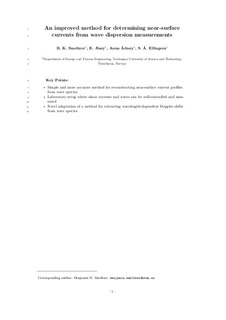| dc.contributor.author | Smeltzer, Benjamin Keeler | |
| dc.contributor.author | Æsøy, Eirik | |
| dc.contributor.author | Ådnøy, Anna | |
| dc.contributor.author | Ellingsen, Simen Andreas Ådnøy | |
| dc.date.accessioned | 2020-02-10T12:33:37Z | |
| dc.date.available | 2020-02-10T12:33:37Z | |
| dc.date.created | 2020-01-21T11:31:44Z | |
| dc.date.issued | 2019 | |
| dc.identifier.citation | Journal of Geophysical Research (JGR): Oceans. 2019, 124 (12), 8832-8851. | nb_NO |
| dc.identifier.issn | 2169-9275 | |
| dc.identifier.uri | http://hdl.handle.net/11250/2640726 | |
| dc.description.abstract | A new inversion method for determining near‐surface shear currents from a measured wave spectrum is introduced. The method is straightforward to implement and starts from the existing state‐of‐the‐art technique of assigning effective depths to measured wavenumber‐dependent Doppler shift velocities. A polynomial fit is performed, with the coefficients scaled based on a simple derived relation to produce a current profile that is an improved estimate of the true profile. The method involves no user‐input parameters, with the optimal parameters involved in the polynomial fit being chosen based on a simple criterion involving the measured Doppler shift data only. The method is tested on experimental data obtained from a laboratory where current profiles of variable depth dependence could be created and measured by particle image velocimetry, which served as “truth” measurements. Applying the new inversion method to experimentally measured Doppler shifts resulted in a >3 times improvement in accuracy relative to the state of the art for current profiles with significant near‐surface curvature. The experiments are dynamically similar to typical oceanographic flows such as wind‐drift profiles, and our laboratory thus makes a suitable and eminently useful scale model of the real‐life setting. Our results show that the new method can achieve improved accuracy in reconstructing near‐surface shear profiles from wave measurements by a simple extension of methods, which are currently in use, incurring little extra complexity and effort. A novel adaptation of the normalized scalar product method has been implemented, able to extract Doppler shift velocities as a function of wavenumber from the measured wave spectrum. | nb_NO |
| dc.language.iso | eng | nb_NO |
| dc.publisher | Wiley | nb_NO |
| dc.title | An Improved Method for Determining Near‐Surface Currents From Wave Dispersion Measurements | nb_NO |
| dc.type | Journal article | nb_NO |
| dc.type | Peer reviewed | nb_NO |
| dc.description.version | acceptedVersion | nb_NO |
| dc.source.pagenumber | 8832-8851 | nb_NO |
| dc.source.volume | 124 | nb_NO |
| dc.source.journal | Journal of Geophysical Research (JGR): Oceans | nb_NO |
| dc.source.issue | 12 | nb_NO |
| dc.identifier.doi | 10.1029/2019JC015202 | |
| dc.identifier.cristin | 1779069 | |
| dc.description.localcode | Locked until 1.11.2020 due to copyright restrictions. This is the peer reviewed version of an article, which has been published in final form at [http://dx.doi.org/10.1029/2019JC015202]. This article may be used for non-commercial purposes in accordance with Wiley Terms and Conditions for Self-Archiving. | nb_NO |
| cristin.unitcode | 194,64,25,0 | |
| cristin.unitname | Institutt for energi- og prosessteknikk | |
| cristin.ispublished | true | |
| cristin.fulltext | original | |
| cristin.fulltext | postprint | |
| cristin.qualitycode | 2 | |
